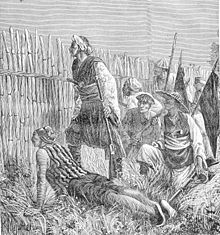Black flags
The black flags (also black flags , black banners or black ho , French: pavilions noirs , Chinese 黑旗軍 , Vietnamese Quân Cờ Đen ) were formerly Chinese rebels who settled in northern Vietnam from 1865 and fought against the advancing French . By these, they were viewed as bandits or pirates.
Emergence
After the Taiping Uprising was put down in 1864, one of the rebel groups, Chinese marauders of the Ho - a so-called flag gang, fled to Tonking on the upper part of the Red River . There the Black Flags under Liu Yongfu controlled the course of the river between Sơn Tây and Lào Cai and achieved a certain degree of independence. They hindered the French in the economic penetration of the area, for example, only allowed traders to pass under high road tariffs and thus made any trade unprofitable.
By 1869 they were able to prevail against a competing group, the Yellow Flags. The black flags became very useful to the Vietnamese government as they kept the troubled hill tribe of the area under control.
Customs were lucrative, the black flags became rich and in the 1870s consisted of 7,000 men, mostly Chinese from Guangdong and Guangxi , but also adventurers from America and Europe.
Fight the French
In December 1873 they defeated a French force under Francis Garnier .
In 1882 the French took action against the disturbance of their trade and sent a force under the naval officer Henri Rivière . However, he attacked Vietnamese troops without authorization. The Vietnamese government then sought support from its protective power China and the black flags.
On May 10, 1883, Liu Yongfu had an oversized invitation to the French posted on the city walls of Hanoi to present themselves to battle. Then on May 19th the battle of the paper bridge broke out . Rivière attacked a strong Black Flag defense position near the village of Cầu Giấy, a few kilometers west of Hanoi, with around 450 soldiers. After initially looking like the Black Flags couldn't withstand the French onslaught, they later managed to break through on both wings. Rivière and other officers were killed in the course of the battle, and the French were barely able to retreat to Hanoi.
In the summer, the new commander of the Tonkin expeditionary force, Admiral Amédée-Anatole Courbet, attacked the positions of the black flags on the Sông Đáy river. Although the French were able to win the Battle of Phu Hoai on August 15th and the Battle of Palan on September 1st, they were unable to conquer all positions of the black flags, which is why both battles were considered French defeats by the world public .
For the end of 1883, the French were preparing a major offensive to crush the Black Flag forces and get China to stop aid to Liu Yongfu.
In December, Admiral Courbet advanced on Son Tay in the largest French operation to date . In addition to the black flags, the city was also defended by small Chinese and Vietnamese contingents. On December 14th, the French attacked the upstream defense positions at Phu Sa, but were repulsed with heavy losses. A night-time counterattack ordered by Liu Yongfu was also denied. After both sides had reorganized the following day, Courbet put Son Tay under artillery fire on the 16th and ordered an assault that afternoon. At around 5 p.m., the French were able to capture the west gate and advance into the city. The defenders withdrew to the citadel and a few hours later escaped from the city under cover of darkness. Although the French suffered high losses by their standards of 83 dead and 320 wounded, they were so bad at the black flags that some observers saw them as no longer able to carry out serious operations on their own in the future. Liu Yongfu himself took the defeat as a warning not to proceed alone if possible, but to seek the support of the Chinese and Vietnamese troops.
War and end
These clashes led to the Sino-French War (August 1884 to April 1885), in which Chinese armies fought against the French in Tonkin with the support of the Black Flags. So it came to the battle of Yu Oc on November 19th .
With the end of the war, the black flags disbanded, but many former members continued to live in independent bandits.
After the invasion of Taiwan by Japan in 1895, the name black flags came back to life. Liu Yongfu supported his friend Tang Jingsong , the president of the short-lived Republic of Formosa , and led the local resistance against the Japanese with the help of old comrades in arms. With the Japanese conquest of Tainan on October 21st, resistance collapsed and Liu fled back to the mainland.
Web links
literature
- Bradley Camp Davis: States of Banditry: The Nguyen Government, Bandit Rule, and the Culture of Power in the Post-Taiping China-Vietnam Borderlands , ProQuest, 2008
Individual evidence
- ^ Louis Roger Gérard de Marolles: La dernière Campagne du Commandant Rivière 1881-1883. 1932, pp. 192-222.
- ^ E. Duboc: Trente-cinq mois de campagne en Chine, au Tonkin. 1899, pp. 123-139.
- ↑ Lucian Huard: La guerre du Tonkin. 1887, pp. 6-16.
- ↑ Lucian Huard: La guerre du Tonkin. 1887, pp. 180-187 and 202-231.


